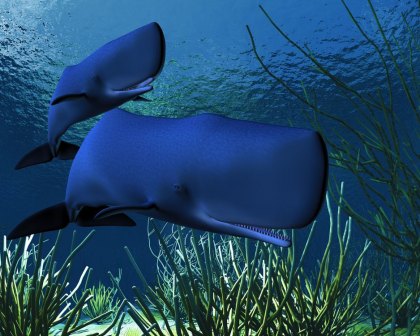Moby Dick ramming more than a fish story

As it turns out, that amazing forehead could have done the job, according to research published this month in the journal PeerJ.
The classic, written by Herman Melville and published in 1851, was fiction -- but based on a real whaling disaster that has been the focus of debate.
The newly released research, led by Olga Panagiotopoulou, evolutionary morphologist at University of Queensland in Australia, reports that the Moby Dick scenario is plausible. Here is the rundown:
- The “ramming” theory was proposed by whalers following the sinking of two ships, the Essex in 1820 and the Ann Alexander in 1851.
A wildlife pilot, however, witnessed sperm whales ramming while flying over the Gulf of California in 1997. “This observation, plus reports of ramming attacks on 19th century whaling ships, suggest that sperm whales may indeed engage in ramming contests. If these ramming contests generally occur at a shallow depth, they may be much more common than whale biologists realize because a human observer would have to be located well above the surface of the water to watch it happen.”
To get a sense of the force involved: A male sperm whale can be about 56 feet in length and weigh 45 tons, according to the National Oceanic and Atmospheric Administration. The females are about 36 feet in length and weigh 15 tons. Even so, the study points out that the sperm whales would have been using their heads as "a battering ram capable of sinking ships that are four to five times the mass of the whale."
- The background -- the sperm whale’s broad forehead has two compartments.
Researchers call the sperm whale’s forehead “the largest, and one of the strangest, anatomical structures in the animal kingdom. It contains two large oil-filled compartments, known as the ‘spermaceti organ’ and ‘junk,’ that constitute up to one-quarter of body mass and extend one-third of the total length of the whale,” the paper explains.
- Researchers set out to determine whether connective tissue partitions of the “junk” could reduce stress in the bones of the skull upon impact – thus allowing the sperm whale to make mincemeat of a whaling boat.
In an attempt to get an answer, researchers used modeling and simulation. They varied the application point of the impact force, the study recounted. Findings suggested “that the connective tissue partitions of the junk may reduce impact stresses and thus potentially function as a protective mechanism during ramming.”
- Findings of this study are consistent with a hypothesis made in 1821 by Owen Chase.
Chase, first mate on the doomed whaler Essex, later wrote an account of the disaster.
As he put it, “the whale’s head is admirably designed for this mode of attack.”
Related:
Nature In Brief -- Research spotlights the long lives of sharks; older trees grow faster
If you would like to comment, give us a shout, or like us on Facebookand tell us what you think.

